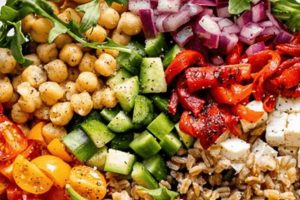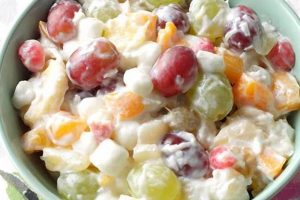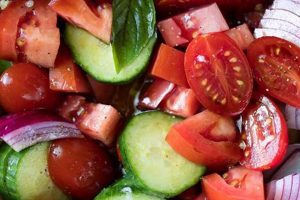This vibrant salad, a staple of Eastern European cuisine, typically combines diced cooked beets with potatoes, carrots, pickles, and sometimes other vegetables like onions or sauerkraut. It’s all bound together with a mayonnaise-based dressing, often seasoned with dill, salt, and pepper. Variations exist, including the addition of meat, fish, or beans, showcasing its adaptability and regional diversity. A simple version might include only beets, potatoes, and mayonnaise, while more elaborate recipes can resemble a composed salad with layered ingredients.
Nutrient-rich beets offer a source of antioxidants and dietary fiber, contributing to the salad’s nutritional value. Its cool, refreshing nature makes it a popular choice for warmer months or as a side dish alongside heartier meals. With roots in pre-revolutionary Russia, the dish has evolved over time, reflecting both culinary traditions and available ingredients. Its enduring popularity speaks to its satisfying flavors and relative ease of preparation, making it a beloved dish across generations and cultures.
The following sections will delve into specific variations, offer step-by-step instructions, and provide helpful tips for achieving optimal results. From selecting the freshest produce to mastering the perfect dressing, readers will gain the knowledge and confidence to create their own version of this classic dish.
Tips for Preparing a Delicious Beetroot Salad
Achieving optimal flavor and texture requires attention to detail throughout the preparation process. These tips offer guidance for creating a truly exceptional salad.
Tip 1: Beet Selection and Cooking: Opt for firm, smooth-skinned beets of uniform size for even cooking. Boiling or roasting beets preserves their vibrant color and nutrients. Roasting imparts a subtle sweetness.
Tip 2: Handling Beets: Wear gloves when handling beets to avoid staining hands. Peel cooked beets under cold running water to simplify the process.
Tip 3: Ingredient Preparation: Dice all vegetables into uniform pieces for a visually appealing presentation and even distribution of flavors. This ensures a balanced bite.
Tip 4: Dressing Consistency: The mayonnaise-based dressing should be thick enough to coat the vegetables without being overly heavy. Adjust consistency by adding small amounts of milk or sour cream if needed.
Tip 5: Seasoning: Fresh dill is the preferred herb, adding a bright, herbaceous note. Salt and pepper should be added to taste, balancing the sweetness of the beets.
Tip 6: Chilling Time: Allowing the salad to chill for at least an hour before serving allows the flavors to meld and the salad to develop its characteristically refreshing taste.
Tip 7: Garnishing and Serving: A sprinkle of fresh dill or a dollop of sour cream elevates the presentation. Serve chilled as a side dish or light meal.
By following these tips, one can elevate this simple salad to a culinary masterpiece. Careful attention to detail, from ingredient selection to chilling time, contributes significantly to the final result.
With a thorough understanding of these key elements, one can confidently embark on creating a truly memorable beetroot salad experience.
1. Beets (cooked, diced)
Cooked, diced beets constitute the foundational ingredient of Russian beetroot salad, contributing not only its distinctive color but also its earthy sweetness and substantial texture. An understanding of beet preparation and its impact on the final dish proves crucial for achieving optimal results.
- Cooking Methods:
Boiling or roasting beets affects both their flavor and texture. Boiling yields a softer, more delicate texture, while roasting intensifies the natural sweetness and creates slightly firmer pieces. The choice of cooking method influences the overall salad experience. Boiling preserves more of the beet’s earthy flavor, while roasting adds a nuanced caramelization.
- Dicing Technique:
Uniform dicing ensures even cooking and a balanced distribution of flavor and texture throughout the salad. Smaller dice creates a finer texture, while larger dice provides a more substantial bite. Consistency in size contributes to the visual appeal and overall enjoyment of the dish.
- Color and Flavor Profile:
The deep red-purple hue of beets imparts a vibrant color to the salad. Their earthy sweetness balances the acidity of other ingredients, such as pickles or sauerkraut, creating a complex flavor profile. This balance of sweet and tangy is a hallmark of the dish.
- Nutritional Contribution:
Beets are a good source of essential nutrients, including fiber, folate, and nitrates. Their inclusion contributes to the overall nutritional value of the salad, adding a healthful component to this culinary classic. The presence of these nutrients further enhances the appeal of this dish.
The careful preparation of beetsfrom cooking method to dicing techniquedirectly impacts the final flavor, texture, and visual appeal of Russian beetroot salad. Understanding these facets allows for a more nuanced appreciation of this staple dish and empowers culinary exploration through informed choices regarding beet preparation.
2. Potatoes (cooked, diced)
Cooked, diced potatoes play a crucial role in a Russian beetroot salad recipe, providing textural contrast and a neutral base that complements the other ingredients. Their starchy nature contributes a creamy texture when combined with the mayonnaise-based dressing, creating a harmonious balance against the more assertive flavors of beets and pickles. This textural interplay is essential for the salad’s overall appeal. The relatively bland flavor of potatoes allows the brighter, more pronounced flavors of other components to shine without being overpowering. For example, the earthy sweetness of beets and the tanginess of pickles are both enhanced by the presence of the mild potato. This neutrality also allows for variations in seasoning and the inclusion of other ingredients without compromising the salad’s overall balance.
The choice of potato variety influences the final texture. Waxy potatoes, such as red bliss or fingerling, hold their shape well after cooking and dicing, contributing a firmer texture to the salad. This firmness contrasts nicely with the softer texture of the beets. Conversely, starchy potatoes, such as russets, tend to break down more easily when cooked, creating a creamier, more cohesive texture when mixed with the dressing. This creaminess enhances the overall richness of the salad. The selection of potato variety, therefore, offers an opportunity to tailor the salad’s texture to individual preferences.
Careful preparation of the potatoes is essential. Overcooked potatoes can become mushy, detracting from the desired textural contrast. Undercooked potatoes, on the other hand, can be unpleasantly firm. Achieving the proper degree of doneness ensures the potatoes contribute the desired texture and flavor to the salad. Proper dicing technique further enhances the aesthetic appeal and ensures even distribution of flavor and texture throughout the dish. The size of the dice can also be adjusted to match the size of the other diced vegetables, contributing to visual harmony. Understanding the role and preparation of potatoes enhances appreciation for their contribution to a well-balanced and flavorful Russian beetroot salad.
3. Carrots (cooked, diced)
Carrots, when cooked and diced, contribute a subtle sweetness and a pleasant textural element to Russian beetroot salad. Their presence offers not only nutritional value but also a nuanced layer of flavor that complements the dominant earthiness of beets. The sweetness of carrots acts as a counterpoint to the tangy notes from pickles and the richness of the mayonnaise dressing, creating a balanced flavor profile. This balance prevents the salad from becoming overly dominated by any single flavor, allowing for a more complex and enjoyable culinary experience. Furthermore, the inclusion of carrots adds visual appeal with their bright orange hue contrasting against the deep red of the beets, creating a visually vibrant dish. This visual appeal enhances the overall presentation and can stimulate appetite.
The cooking process softens the carrots, ensuring they integrate seamlessly with the other ingredients. Dicing them into uniform pieces allows for even distribution of flavor and texture throughout the salad. This uniformity enhances the eating experience by providing a consistent bite. While some recipes call for raw grated carrots, cooking them allows for a deeper integration of flavor and prevents the carrots from having a raw, crunchy texture that might clash with the other softer elements of the salad. The method of cooking can also influence the carrots’ flavor contribution; boiling retains a milder sweetness, while roasting can intensify their sweetness and add a subtle caramelization.
The addition of carrots to this classic salad demonstrates the interplay of flavors, textures, and colors in creating a balanced and appealing dish. From a nutritional perspective, carrots provide a source of Vitamin A and other essential nutrients, further enhancing the health benefits of the salad. Understanding the role of carrots in this recipe allows for informed choices in preparation methods and highlights the importance of each component in contributing to the overall culinary experience. This careful consideration of ingredients elevates a simple salad to a complex and satisfying dish, showcasing the interplay of flavors and textures achievable with relatively simple components.
4. Pickles (diced)
Diced pickles provide a crucial acidic counterpoint within the flavor profile of Russian beetroot salad, cutting through the richness of the mayonnaise and the earthy sweetness of the beets. This acidity introduces a refreshing element that brightens the overall taste and prevents the salad from becoming overly heavy. The sourness from pickles also complements the other vegetables, particularly the carrots and potatoes, adding a layer of complexity that elevates the dish beyond a simple combination of ingredients. The specific type of pickle used can further influence the flavor profile. For instance, dill pickles offer a herbaceous note that complements the fresh dill often used in the dressing, while sour pickles contribute a more pronounced tang. The choice of pickle, therefore, allows for subtle adjustments to the overall flavor balance. This interplay of flavors highlights the importance of considering each ingredient’s contribution to the final composition.
Beyond flavor, diced pickles contribute a textural dimension to the salad. Their crispness contrasts with the softer textures of the cooked beets, potatoes, and carrots, introducing a satisfying textural variation. This contrast prevents the salad from becoming monotonous in texture and adds to the overall enjoyment of the dish. The size of the pickle dice also plays a role in the textural experience. Smaller dice integrates more seamlessly with the other ingredients, while larger dice offers a more pronounced crunch. This choice allows for customization based on individual preferences. The textural contribution of pickles further underscores their importance as a key component of this classic salad. One can observe similar principles in other culinary traditions where pickled elements are used to balance richness and add textural complexity, such as in Vietnamese banh mi or Middle Eastern salads. This cross-cultural application highlights the universality of using pickled elements to enhance flavor and texture.
The inclusion of diced pickles in Russian beetroot salad demonstrates a sophisticated understanding of flavor balancing and textural interplay. This seemingly simple ingredient contributes significantly to the complexity and overall appeal of the dish. From the acidic counterpoint to the textural variation, pickles play a crucial role in elevating the salad beyond a simple combination of ingredients. The versatility in pickle selection further allows for nuanced flavor adjustments, showcasing the depth of culinary possibilities within this traditional recipe. Understanding the function of pickles within this specific context provides insight into the broader principles of flavor balancing and texture management in culinary arts.
5. Mayonnaise (dressing base)
Mayonnaise serves as the foundational element of the dressing in Russian beetroot salad, binding the ingredients together and contributing a creamy richness that balances the other flavors. Its role extends beyond simply holding the salad together; it significantly influences the overall texture, flavor profile, and perceived richness of the dish. The quality and type of mayonnaise employed can considerably alter the final result, impacting the salad’s overall taste and consistency. An exploration of mayonnaise’s function within this culinary context reveals its crucial role in creating a harmonious and balanced dish.
- Texture and Emulsification:
Mayonnaise provides a smooth, creamy texture that coats the vegetables, creating a cohesive and palatable experience. Its emulsifying properties allow the oil and vinegar (or lemon juice) in the dressing to combine into a stable mixture, preventing separation and ensuring a consistent texture throughout the salad. This emulsification is crucial for the dressing’s ability to cling to the vegetables and deliver its flavor evenly. Without a stable emulsion, the salad would be oily and less appealing.
- Flavor Enhancement and Balance:
The rich, tangy flavor of mayonnaise complements the earthy sweetness of the beets and the acidity of the pickles. It acts as a bridge between these contrasting flavors, creating a harmonious balance. The subtle tanginess of mayonnaise also enhances the overall flavor profile, adding depth and complexity. Different types of mayonnaise, such as those made with olive oil or flavored with herbs, can further enhance the flavor profile of the salad, adding nuanced notes that complement the other ingredients.
- Moisture and Mouthfeel:
Mayonnaise adds moisture to the salad, preventing it from becoming dry and ensuring a pleasant mouthfeel. This moisture also contributes to the perceived richness of the dish, making it more satisfying and enjoyable. The amount of mayonnaise used can be adjusted to achieve the desired level of moisture and creaminess, catering to individual preferences. Using too little mayonnaise can result in a dry salad, while using too much can make it overly rich.
- Variations and Adaptations:
While traditional recipes typically use plain mayonnaise, variations exist, incorporating sour cream, yogurt, or a combination thereof for a lighter or tangier dressing. These adaptations allow for customization of the salad’s flavor and texture according to individual preferences or dietary needs. For example, using sour cream adds a tangy complexity, while Greek yogurt contributes a lighter, more refreshing element.
The careful selection and utilization of mayonnaise in Russian beetroot salad demonstrate its significance beyond a mere binding agent. It functions as a critical component that contributes to the salad’s texture, flavor balance, and overall appeal. Understanding its multifaceted role allows for informed choices regarding mayonnaise type and quantity, empowering culinary creativity and ensuring a delicious and satisfying final product. The interplay between mayonnaise and the other ingredients highlights the importance of considering each component’s contribution to the harmonious balance of flavors and textures that define this classic dish.
6. Dill (fresh, chopped)
Fresh, chopped dill holds a prominent position within the flavor profile of Russian beetroot salad, contributing a bright, herbaceous note that complements and balances the other ingredients. This herb offers a distinct aromatic lift that cuts through the richness of the mayonnaise and the earthiness of the beets, creating a more complex and refreshing flavor experience. Dill’s presence elevates the salad beyond a simple combination of root vegetables and dressing, transforming it into a balanced and nuanced culinary creation. The volatile oils within dill contribute to its characteristic aroma and flavor, imparting a refreshing, slightly tangy, and subtly anise-like taste that enhances the overall sensory experience. Omitting dill would result in a noticeably flatter flavor profile, lacking the characteristic brightness and herbal complexity. One can observe a similar application of dill in other Eastern European cuisines, such as in Polish cucumber salad (mizeria) or in various potato salads, demonstrating its versatility and affinity for root vegetables and creamy dressings. These examples underscore dill’s integral role in regional culinary traditions.
Beyond its aromatic contribution, fresh dill adds a visual element to the salad, its vibrant green fronds contrasting beautifully with the deep red of the beets and the lighter hues of the potatoes and carrots. This visual contrast enhances the presentation, making the salad more appealing to the eye. The finely chopped texture of the dill also contributes a subtle textural element without detracting from the other textures present in the salad. This delicate textural addition further enhances the overall sensory experience. The use of fresh dill is preferred over dried dill in this context, as the fresh herb offers a more pronounced aroma and flavor. Dried dill can be used as a substitute in cases where fresh dill is unavailable, but the flavor intensity will be diminished. The quantity of dill used can be adjusted based on personal preference, but even a small amount contributes significantly to the overall flavor profile.
The integration of fresh, chopped dill within Russian beetroot salad exemplifies the importance of considering not only the individual flavors of ingredients but also their aromatic and visual contributions. Dill’s presence transforms the salad into a more complex and engaging culinary experience, highlighting the interplay of flavors, aromas, and textures. This understanding underscores the significance of fresh herbs in culinary practices and their power to elevate simple dishes into memorable culinary experiences. The specific application of dill within this context also provides insight into the broader principles of flavor balancing and aromatic enhancement in culinary arts, demonstrating how a seemingly minor ingredient can significantly impact the final product.
7. Seasoning (salt, pepper)
Seasoning, specifically salt and pepper, plays a crucial role in the final flavor profile of Russian beetroot salad. Salt enhances the inherent sweetness of the beets and other vegetables, while pepper adds a subtle layer of complexity and depth. The interplay of these two seasonings elevates the salad from a simple combination of ingredients to a more balanced and nuanced dish. Careful seasoning amplifies the existing flavors, creating a more harmonious and palatable experience. Without proper seasoning, the individual flavors of the beets, potatoes, carrots, and pickles may not fully express themselves, resulting in a bland or underwhelming salad. Salt also acts as a natural preservative, extending the salad’s shelf life, a practical consideration relevant to its traditional preparation in larger quantities for family meals or celebrations. Historically, this preservation aspect was particularly crucial in times before widespread refrigeration.
The quantity of salt and pepper used can significantly influence the overall taste. Over-salting can mask the delicate flavors of the vegetables, while under-salting can result in a flat, unappealing taste. The balance must be carefully calibrated to enhance, not overpower, the other components. Freshly ground black pepper is generally preferred for its more robust aroma and flavor compared to pre-ground pepper. The coarseness of the grind can also influence the sensory experience, with coarser grinds providing a more pronounced textural element. Furthermore, variations in seasoning can be explored; for instance, a touch of white pepper can add a subtle heat without altering the salad’s color. The adaptability of seasoning allows for personalized adjustments to suit individual palates or to complement specific variations of the recipe. For example, if the salad includes pickled herring, a slightly more assertive seasoning might be preferred to balance the fish’s saltiness.
Achieving the proper balance of salt and pepper in Russian beetroot salad demonstrates a fundamental principle of culinary practice: the transformative power of simple seasonings. Careful attention to this seemingly minor detail can significantly impact the final dish, elevating it from simple to extraordinary. The interplay of salt and pepper, enhancing the sweetness and adding complexity, exemplifies the importance of precise seasoning in achieving a well-balanced and flavorful final product. The practical considerations of preservation and adaptability further highlight the significance of this step in the context of both traditional and contemporary culinary practices. This understanding translates across culinary traditions, underscoring the universal importance of seasoning in maximizing the flavor potential of any dish.
Frequently Asked Questions
This section addresses common inquiries regarding the preparation and variations of Russian beetroot salad, offering clarity and guidance for achieving optimal results.
Question 1: What is the best way to cook beets for this salad?
Both boiling and roasting produce desirable results, each imparting distinct characteristics. Boiling yields a softer texture and retains the beet’s earthy flavor, while roasting intensifies the sweetness and creates a firmer texture. The preferred method depends on individual preference.
Question 2: Can other vegetables be added to this salad?
While the core ingredients remain consistent, variations often incorporate sauerkraut, green peas, or chopped onions. Such additions contribute textural and flavor complexity. However, the balance of flavors should be carefully considered.
Question 3: How long can the salad be stored in the refrigerator?
Properly stored in an airtight container, the salad typically lasts for three to five days in the refrigerator. However, the quality and texture may degrade over time. It’s recommended to consume it within two days for optimal flavor and freshness.
Question 4: Can canned beets be used instead of fresh beets?
While canned beets offer convenience, fresh beets are generally preferred for their superior flavor and texture. Canned beets tend to have a softer texture and a slightly metallic taste, which can affect the overall quality of the salad. If canned beets are used, rinsing them thoroughly can help reduce any lingering metallic flavor.
Question 5: What type of mayonnaise is recommended for the dressing?
Traditional recipes often use plain mayonnaise. However, variations incorporating sour cream or yogurt provide a lighter, tangier alternative. The choice depends on individual preference and desired flavor profile. High-quality mayonnaise generally results in a superior salad.
Question 6: Is this salad traditionally served warm or cold?
Russian beetroot salad is traditionally served chilled. The cold temperature enhances the refreshing qualities of the dish, especially during warmer months. Chilling also allows the flavors to meld and develop fully.
Understanding these aspects of preparation and storage allows for greater control over the final product, ensuring a delicious and authentic culinary experience. Careful consideration of each element contributes to the creation of a truly satisfying Russian beetroot salad.
Further exploration of regional variations and serving suggestions can enrich one’s appreciation for this classic dish. The following sections will delve into these nuances, offering deeper insights into its cultural significance and culinary versatility.
Conclusion
Exploration of this classic dish reveals a deceptively simple composition yielding a complex interplay of flavors and textures. From the earthy sweetness of beets to the tangy brightness of pickles, each ingredient contributes a distinct characteristic, culminating in a harmonious balance. Careful consideration of cooking methods, dicing techniques, and seasoning elevates the final product. The adaptability of the recipe allows for personalized variations while maintaining its essential character.
This enduring culinary creation represents more than a mere salad; it reflects cultural heritage and culinary ingenuity. An understanding of its core components and their interactions empowers culinary exploration and appreciation for the nuanced artistry within seemingly simple dishes. Continued experimentation and adaptation promise further evolution and enjoyment of this timeless classic.






